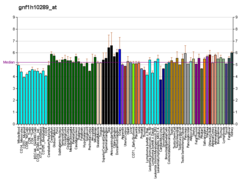| TAAR1 | |||||||||||||||||||||||||||||||||||||||||||||||||||
|---|---|---|---|---|---|---|---|---|---|---|---|---|---|---|---|---|---|---|---|---|---|---|---|---|---|---|---|---|---|---|---|---|---|---|---|---|---|---|---|---|---|---|---|---|---|---|---|---|---|---|---|
 | |||||||||||||||||||||||||||||||||||||||||||||||||||
| Identifiers | |||||||||||||||||||||||||||||||||||||||||||||||||||
| Aliases | TAAR1, TA1, TAR1, TRAR1, trace amine associated receptor 1, Trace amine receptor | ||||||||||||||||||||||||||||||||||||||||||||||||||
| External IDs | OMIM: 609333; MGI: 2148258; HomoloGene: 24938; GeneCards: TAAR1; OMA:TAAR1 - orthologs | ||||||||||||||||||||||||||||||||||||||||||||||||||
| |||||||||||||||||||||||||||||||||||||||||||||||||||
| |||||||||||||||||||||||||||||||||||||||||||||||||||
| |||||||||||||||||||||||||||||||||||||||||||||||||||
| |||||||||||||||||||||||||||||||||||||||||||||||||||
| |||||||||||||||||||||||||||||||||||||||||||||||||||
| Wikidata | |||||||||||||||||||||||||||||||||||||||||||||||||||
| |||||||||||||||||||||||||||||||||||||||||||||||||||
Trace amine-associated receptor 1 (TAAR1) is a trace amine-associated receptor (TAAR) protein that in humans is encoded by the TAAR1 gene.[5] TAAR1 is an intracellular amine-activated Gs-coupled and Gq-coupled G protein-coupled receptor (GPCR) that is primarily expressed in several peripheral organs and cells (e.g., the stomach, small intestine, duodenum, and white blood cells), astrocytes, and in the intracellular milieu within the presynaptic plasma membrane (i.e., axon terminal) of monoamine neurons in the central nervous system (CNS).[6][7][8][9] TAAR1 was discovered in 2001 by two independent groups of investigators, Borowski et al. and Bunzow et al.[10][11] TAAR1 is one of six functional human trace amine-associated receptors, which are so named for their ability to bind endogenous amines that occur in tissues at trace concentrations.[12][13] TAAR1 plays a significant role in regulating neurotransmission in dopamine, norepinephrine, and serotonin neurons in the CNS;[7][12] it also affects immune system and neuroimmune system function through different mechanisms.[14][15][16][17]
TAAR1 is a high-affinity receptor for amphetamine, methamphetamine, dopamine, and trace amines which mediates some of their cellular effects in monoamine neurons within the central nervous system.[7][12]
The primary endogenous ligands of the human TAAR1 (hTAAR1) receptor, by rank order of potency, are:
tyramine > β-phenethylamine > dopamine = octopamine.[6]
- ^ a b c GRCh38: Ensembl release 89: ENSG00000146399 – Ensembl, May 2017
- ^ a b c GRCm38: Ensembl release 89: ENSMUSG00000056379 – Ensembl, May 2017
- ^ "Human PubMed Reference:". National Center for Biotechnology Information, U.S. National Library of Medicine.
- ^ "Mouse PubMed Reference:". National Center for Biotechnology Information, U.S. National Library of Medicine.
- ^ "Entrez Gene: TAAR1 trace amine associated receptor 1".
- ^ a b Cite error: The named reference
TAAR1 IUPHARwas invoked but never defined (see the help page). - ^ a b c Cite error: The named reference
Miller+Grandy 2016was invoked but never defined (see the help page). - ^ Cite error: The named reference
TAAR1 addiction 2015was invoked but never defined (see the help page). - ^ Cite error: The named reference
Berry hTAAR pharmacology December 2017 reviewwas invoked but never defined (see the help page). - ^ Cite error: The named reference
Borowski_2001was invoked but never defined (see the help page). - ^ Cite error: The named reference
Bunzow_2001was invoked but never defined (see the help page). - ^ a b c Cite error: The named reference
Millerwas invoked but never defined (see the help page). - ^ Cite error: The named reference
Lindemann_2005was invoked but never defined (see the help page). - ^ Cite error: The named reference
Cisneros_2014was invoked but never defined (see the help page). - ^ Cite error: The named reference
Rogers_2012was invoked but never defined (see the help page). - ^ Cite error: The named reference
Panas_2012was invoked but never defined (see the help page). - ^ Cite error: The named reference
Babusyte_2013was invoked but never defined (see the help page).
© MMXXIII Rich X Search. We shall prevail. All rights reserved. Rich X Search





